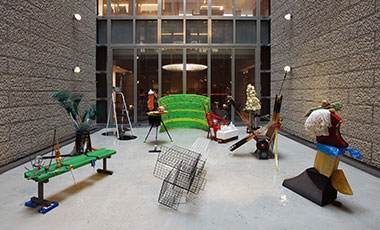Features / Review
History Has Failed Us, But No Matter – If History is unjust, change it
posted 18 Sep 2019
History Has Failed Us, But No Matter – If History is unjust, change it

The Korean Pavilion at The Venice Giardini
There are some notions such as ethics, rationality, identity and even language and history that we have understood within norms and could not easily imagine beyond what is given. However, what is given to us excludes lots of things, the majority of which is constituted by ourselves. For some people, it might be normal to mechanically memorize the history that does not include themselves and to try to fit in a given standard, but for others, it means nothing more than living without a voice. The exhibition at the Korean Pavilion 《History Has Failed Us, But No Matter》 aims to re-narrate modern history which is structured around the West and described based on the canon of the heterosexual male by making the ones excluded from history the agency of narrative. The curator of this exhibition Hyunjin Kim has conducted such projects of exhibit, performance, and publication that critically reexamine the West-oriented modernity. Continued from her previous projects, this exhibition highlights the view of a complex and critical sense of gender in the course of new recognition through collaboration with her fellow female artists siren eun young jung, Hwayeon Nam, and Jane Jin Kaisen.

siren eun young jung, 〈A Performing by Flash, Afterimage, Velocity, and Noise〉, 2019. Audiovisual installation, multi-channel video, dimensions variable.
As described above, this exhibition reexamines, with a multilateral sense of gender, the way that history has been 'written' on the basis where notions of the West and the male are generalized and neutralized. And it does not hesitate to employ various elements to reveal the evolved awareness such as the structure, movement, and rhythm of the entire exhibition in addition to the individual works. On the upper part of the Korean Pavilion is written a declarative phrase 'History has failed us, but no matter' in gold, and the image of a gukgeuk (Korean traditional theater) actor Lee Deung Woo, the work of siren eun young jung, in enormous size and high resolution is facing outside the exhibit space from the inside of circular glass wall, looking at people who have yet to enter. The interior shows a distinct feature from its powerful exterior. While the main exhibition of Venice Biennale and several other national pavilions immediately attract audiences' attention with huge and spectacular works and audiences could view the entire show at a glance, the Korean pavilion welcomes the audience with a white wall and suggests no specific order of movement. The audiences are only to choose from several equally reasonable ways of viewing, either they habitually walk to the right side or they walk to the left side following the curious sound and vibration, or they can reach for the black curtain placed at the nearest distance. The structure and details of the whole space consisting of a curved wall, circular stepped seats in a form of contour line, curtains in different thickness and texture hung on the curved rail show distinct approach from white which emphasizes the appropriate position of viewing and visuality of works.
What leads this exhibition is not 'visual' sensation that has been acknowledged as the normative sensation. Visuality, of course, cannot be disregarded at the exhibition that introduces three artists who work with videos, it, however, uses quite of auditory and tactile elements to expand the sensation of the exhibition that usually has been strictly centered on visual sensation. For siren eun young jung's 〈A Performing by Flash, Afterimage, Velocity, and Noise〉 that releases intriguing electronic sound at the entrance, the massive speaker installed on the floor plays as much important role as projection fills three walls, and it generates tactile sound that echoes through the entire body, not stimulating only one sensation or the other. Although audiences are no longer be able to clearly and rationally grasp the screen, surrounded by a three-sided video flickering as it excessively overwhelms the viewer, they can enjoy and sense the work by a new way with the sound that stimulates not only their ears but the entire body. This is when the audience tangibly perceive what Luce Irigaray proposes as ‘the feminine,’ or the notion of touch in contrast to visuality which phallocentrism in Western philosophy has postulated as the only normative and rational sensation while suppressing the physical and feminine thinking.
Starting from 〈The Masquerading Moments〉 (2009) and 〈Masterclass〉 (2010), siren eun young jung continued the project to explore the performance of gender and experience of affect through research on yeoseong gukgeuk, a genre of Korean traditional theater that features only women actors, and the actors who carry out, in a variety of ways such as video, performance, archive, and play. Genealogy of queer aesthetic that jung has discovered from the Yeoseong Gukgeuk project is extended to a transgender musician KIRARA, a disabled female producer and actress Seo Ji Won, a lesbian play actress Yii Lee, and Drag King AZANGMAN. The images of the four artists that resist to the canon of performance circles are hard to capture within the existing language, and those are rapidly overlapped in KIRARA's electronic music with hardly any words. A nonverbal moment where the body of audiences overlapped with flash, afterimage, velocity and noise on their dance-like movement that take up the whole screen, seems puzzling but is instinctively suggested.

Hwayeon Nam, 〈Dancer from the Peninsula〉, 2019. Multi-channel video installation, dimensions variable.
The ambiguous language and sensations that occur outside visuality are also seen in the space of Hwayeon Nam and her works. An actual person Choi Seung-hee, the heroine of 〈Dancer from the Peninsula〉, was the first Korean cosmopolitan dancer and a complex figure who disturbed the boundary of rigid nationalism and deeply reflected on 'East Asian Dance.' The main video, based on Choi Seung-hee's letter to her teacher and other relevant materials, is played in front of a clear glass window, mingling with the Venetian ocean view, and the other four videos of this work are installed horizontally throughout the space, designed to have organic curves and multiple steps. The videos seem to have the effect of uplifting and descending at a position where they have different heights from relational things and the audience has to sit and look down. With a mixture of tactile vibration of flower resulted from too vivid resolution, the soundless movement of dancer that makes the viewer imagine its resonance, lines recited in mixed languages, and only partly extracted images, 〈Dancer from the Peninsula〉 creates a complex sensation that cannot be easily perceived. Although 〈A Garden in Italy〉 created in the backyard also does not show any distinct form, or visual spectacles, the trail that embraces the quiet sound of intermittent singing and natural movement of plants extends the sensations generated from the curved structure to the outside.
Meanwhile, the crack and shaking exerted to the dance circles which had been seized by tradition and canon and to the society divided by a firm boundary by Choi Seung-hee who had moved from South Korea to the West, 'imported' East Asian Dance, and ended her life in North Korea are linked to the work of Jane Jin Kaisen who has been addressing diasporic females and their issue of crossing the borders and memory. Beginning with rereading the Bari myth, only known as a beautiful story about its filial duty, 〈Community of Parting〉 tells about princess Bari’s hidden rebellious character with which she independently overcomes her fate and breaks the dichotomous world, and, at the same time, it highlights the life of diasporic women ruined by history and gives them language so that they can speak for themselves. A simbang (shaman in the Jeju vernacular) Koh Soon Ahn who plays an important role in the content, image, and sound of the video, acts as a mediator between this life and afterlife and speaks for people who have lost their voice by performing gut, a ritual for the dead.

Jane Jin Kaisen, 〈Community of Parting〉, 2019. Double-channel video installation, dimensions variable.
Kim Hyesoon that the artist referred for rereading the Bari myth says, "ignition of feminine language can be realized by 'delivering words' just as the shaman's chanting. A dialogic format which involves the audience occurs within the poem through delivering words. Hence, the language of the female poem is an oral language." This work completed with words of the artist herself and the women devastated by the history of wars and separation is presenting a "'physical' poem" after all.
The novel 『Pachinko』 which begins with the same sentence as the title of this exhibition 'History has failed us, but no matter.' is centered on the history of a Korean Japanese family of four generations. The protagonist, Soon-ja, has been alienated and excluded by history, but she has endured suffering and fetters from history all by herself. This powerful beginning sentence is appropriate for the title of this exhibition, for it gives voice to those who have been neglected and underwent injustices as Zainichi unwelcomed by both Korea and Japan. However, while 'no matter' of this novel is great for its easygoing attitude like 'life still goes on,' 'no matter' of the exhibition seems to declare it will change history and aggressively speak out without wielding to the given canon.
The main exhibition of the Biennale 《May You Live In Interesting Times》 also composes half of the artists with women and emphasizes the balance between nations, and invited many works that suggest a rethinking of the issues of nationalism and refugee. But how it centers on media and image in the way of treating art shows a stable and conservative attitude, persisting in the scope and composition of traditional art. As a way of responding to such attitude, national pavilions strengthened the viewpoints of exhibitions or keep the balance of the Biennale by exhibitions with resistant narrative and composition. Taking the position of the latter, the Korean Pavilion led the audience to a diversified point of view and expanded sensations, acquired the language beyond the world homogenized by the West and the heterosexual male, and questioned the formation of unjust history. Also, it was noteworthy that this exhibition attempted to keep rethinking about the method of questioning, the format of exhibition, and how it shows cooperation of female curator and artists who share the same viewpoint.
※ This content was first published in the August, 2019 release of Wolganmisool Magazine and has been re-published on TheARTRO.kr after a negotiation was reached between Korea Arts Management Service and Wolganmisool Magazine.
Sunwoo Nam
Aesthetics. Former curator of Ilmin Museum of Art (Education Department)


